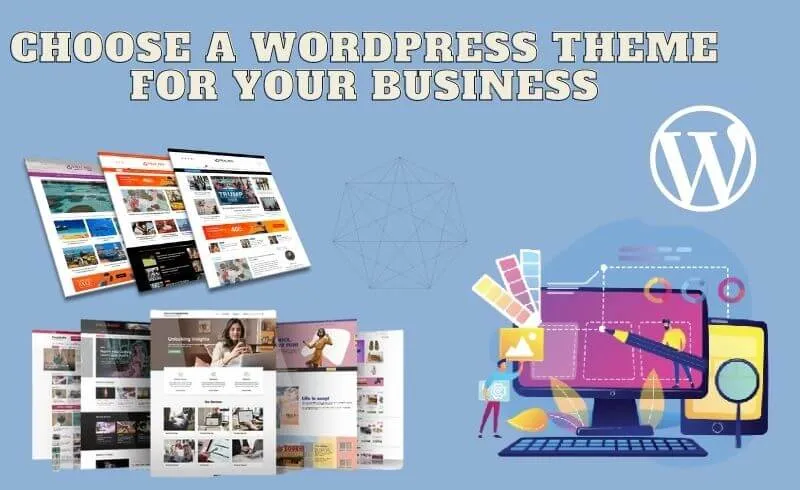How to Choose a WordPress Theme For Your Business – Choosing a template for a WordPress website can make many people feel overwhelmed and confused. No wonder the WordPress platform offers tons of templates that are not only Free but also paid.
Each of them is visually different and functions differently. In this article, you will learn what you need to pay attention to when choosing a template for a WP website.
Table of Contents
Which WordPress theme is best for your website?
Many websites use WordPress and each of them needs a unique template that matches the industry. It should be consistent with the leitmotif of the business. For example, if your company operates in the music industry, the website should be kept in intense colors that are associated with good music.
It’s good to know that many great looking templates can make a website slow, and nobody likes slow pages. Google is definitely not thrilled with slow-acting sites. Remember that the template you choose is the face of your brand and website, and many visitors pay attention to the visual aspects.
WordPress Template – which one to choose? Paid or Free?
One of the benefits of building a website on WordPress is the large selection of free templates. From which you can definitely choose one that will perfectly match the design of the website.
However, if the website owner wants to create something unique, he can choose from paid templates that are created by professional designers. How are they various from the free ones? They have additional functions and features that diversify the appearance and functionality of the website.
Paid template vs Free Template – Differences
Learn the differences between paid and free templates so that you are aware of the pros and cons that each one offers. Paid templates can even cost $100. The free ones are installed directly from the panel.
Paid is downloaded as a zip file and then uploaded to WordPress. Free template updates are developer dependent and may be delayed. The paid updates are usually regular. In the paid template, the code quality is at a high level. In free with quality, it can be different.
The free template can be downloaded by multiple sites. Paid has fewer downloads, has more configuration options, and thus has an original look. While free templates may contain malicious codes, paid templates are less likely to have them.
15 Tips on how to choose a WordPress theme right
If you already know the difference between a paid template and a free one and what the template should generally look like is, it’s time for 15 useful tips that will allow you to choose a personalized look for your website.
1. Make a list of the features you want on the website
Before choosing a WordPress template, it’s a good idea to write down the features that will be needed on your website. The more we define and exclude unnecessary features, the easier it will be to choose the right template.
WordPress allows us to search for the functions that interest us. When building a website, it is sometimes worth putting on a template that will not have many functions. Why? Because sometimes the less the better.
You can download the current version of WordPress with the history of changes from here.
2. Keep it simple
Many WP templates have a lot of options, such as colors, animations or layouts, which sometimes look great on the page. However, in most cases it is unnecessary. Choose a template that is simple and nice looking and fulfilling the purpose for which the website owner created it.
Remember that the website must be transparent so that every visitor can quickly find the information they are looking for. If the template you choose looks great, but doesn’t give you new customers, it’s definitely not a good template.
3. Make sure you are responsive
What is this responsiveness? This is an option that allows you to adjust the page size to the screen of the device that will be viewing your page. In the statistics of browsed websites, mobile devices generate the most traffic.
When Google sees a friendly adapted website for mobile devices, it puts websites higher in the search engine. Remember to make sure the template you choose will be responsive.
4. Bet on your website loading speed
A WordPress theme should by no means slow down your website. Many templates are coded so that the content on the page loads without any delay. However, there are also those with a rich design and many scripts, and thus they can significantly slow down the operation of the website.
5. Good information organization in the WordPress template
Analyze if all the template settings are so well organized that it will be easy for you to navigate the website. Many templates proposed by developers scattered settings all over WordPress, which can be quite a problem.

6. WordPress theme and browser compatibility
This is important when choosing the right template. There are many browsers that viewers use, and it is worth ensuring that your website works without problems on each of them. It is not worth losing website traffic without a template compatible with browsers. Your website must work in any environment! Do not forget about it.
7. Developers and paid template
If the decision was made on a paid template, you need to do thorough research. Check which company provides it and whether it is trustworthy … How the developer’s communication looks like and whether he supports the person who uses his template.
8. Social media in a WordPress template
Make sure the template you choose has built-in social widgets that will share your content. It is not worth stuffing only plugins into the website, which will slow down its operation.
9. Pay attention to the arrangement of the elements
Look where elements such as header, footer and body are located. Why is it so important? Because changing the set elements is much more difficult to rebuild. For example, if you need to move the sidebar from right to left, it can be a time-consuming task.
10. Pay attention to updates
When choosing a WordPress theme, it is important to pay attention to when the last update was made. It’s best to choose templates that have been updated recently. As a result, we will avoid errors that may occur on those that were updated, e.g. a year ago.
11. First, select the demo version
A WordPress template must have a demo version is an essential thing. It’s always better before uploading or buying a template, it is worth checking how it will look on the website. Usually there is a “Preview” button next to the template description.
Read Also: 10 Best WordPress Themes for Digital Magazines
Top 10 Best WordPress Magazine Themes
Top 10 Essential Tips For WordPress Beginners
Top 10 Best Real Estate WordPress Templates
7+ Best WordPress Caching Plugins for Websites
In the demo templates it is not possible to evaluate the whole, but it will allow you to determine the possibilities of the appearance of the page.
12. Integration with plugins
When choosing a template, you need to know what you want. If you plan to have a website in several languages, it is worth ensuring a template that will play well with the WPML extension. If, however, you plan to develop your store, it is worth having WooCommerce plugins.
13. WordPress template optimized for SEO
As a rule, templates are SEO -friendly , which makes them easy to position and optimize. What is a compatible template with Yoast SEO plugin ? The website will achieve higher search rankings.
14. Pay attention to the photo in the header
When choosing a template, pay attention to the image in the header. If it only accepts the horizontal graphic it can crop the photo we selected for our site.
15. Spend as little time as possible choosing your WordPress template
There is nothing worse than getting stuck choosing the right template. The perfect template can be selected for several weeks, and it may not be good for business. It’s best to choose a template that fulfills the most important functions. You can always look for a template that will be the perfect one while the website is already in operation.

Pradeep Sharma is a author the mind behind Techjustify, where I craft insightful blogs on technology, digital tools, gaming, AI, and beyond. With years of experience in digital marketing and a passion for tech innovation, I aim to simplify complex topics for readers worldwide.
My mission is to empower individuals with practical knowledge and up-to-date insights, helping them make informed decisions in the ever-evolving digital landscape.




